Your fermenting pickles can fail for several common reasons, but you'll find most issues are easily preventable. Soft or mushy pickles often result from temperatures above 75°F, weak brine solutions, or leaving the blossom end intact. Dark or discolored pickles typically stem from poor water quality or improper spice selection. To guarantee success, maintain temperatures between 60-70°F, use filtered water, and keep a proper salt concentration of 2-5%. Don't forget to remove surface scum and kahm yeast regularly. Understanding these fundamentals will transform your next batch into crisp, flavorful ferments.
Why Pickles Turn Soft
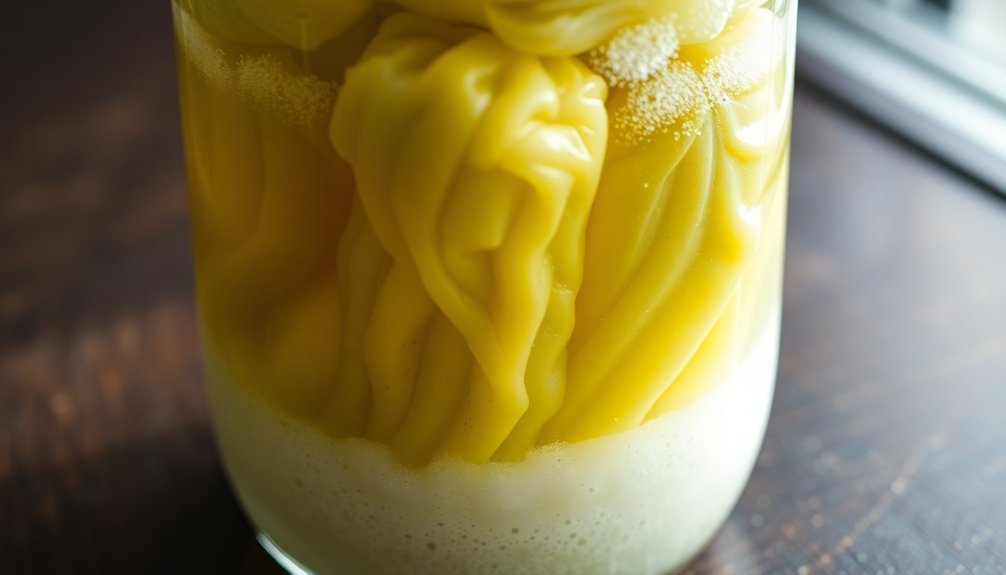
Why do homemade pickles sometimes end up mushy instead of crisp? The most common culprits behind soft pickles are mistakes in temperature control, brine preparation, and cucumber handling during the fermentation process.
If you're storing your fermenting pickles at temperatures above 75°F, you're creating ideal conditions for softening. The best fermentation temperature range is between 70° and 75°F, and anything higher can compromise the pickle's texture.
You'll also run into problems if you haven't removed the blossom ends from your cucumbers, as they contain enzymes that naturally cause softening. For best results, start fermenting your cucumbers within 24 hours of harvest.
Your brine strength plays an essential role too. If you're using a weak brine solution, haven't added enough salt, or have used salt substitutes, you won't achieve the firm texture you're looking for.
The cucumbers themselves matter – if they're overmature or poorly grown, they'll likely turn soft regardless of your technique.
To prevent softening, you'll need to maintain proper brine coverage throughout fermentation and remove any scum that forms on the surface.
Additionally, make sure you're using fresh, quality ingredients – moldy garlic or spices can contribute to pickle softening.
Preventing Dark and Discolored Results
You'll need to start with the right water quality to prevent dark pickles, as minerals in hard water can cause discoloration.
Using non-iodized pickling salt is essential since iodized salt can lead to darkened pickles.
Your choice of equipment matters too, so stick to glass, stoneware, or food-grade plastic containers while avoiding metals like copper or brass that can affect pickle color.
When it comes to spices, opt for whole versions instead of ground ones, and consider placing them in a cheesecloth bag for easy removal before they can cause darkening.
Water Quality Matters Most
A crystal-clear pickle starts with quality water. Your tap water's mineral content and chemical additives can greatly impact your fermentation success. Hard water's minerals interfere with proper acid formation and can leave you with dark, discolored pickles.
Even worse, chlorine in tap water kills the beneficial bacteria essential for fermentation. Maintaining a pH between 2.1-4.5 is critical for safe pickle fermentation.
To guarantee your pickling success, you'll need to treat your water properly before using it. Boil your water for 15 minutes and let it settle for 24 hours to remove minerals and chlorine. Pour off the clear water from the top, being careful not to disturb any settled sediment. Warm this treated water to 100°F (38°C) to help dissolve your salt, then cool it to room temperature before adding it to your cucumbers.
- Use distilled or filtered water if you're unsure about your tap water quality
- Let chlorinated water sit uncovered for at least 30 minutes to allow chlorine evaporation
- Remove minerals from hard water by boiling and settling for 24 hours
- Avoid water with high levels of lead or other contaminants that could affect fermentation
Spice Selection and Storage
Selecting and storing the right spices makes all the difference between vibrant, flavorful pickles and dark, discolored ones. You'll want to use whole spices rather than ground versions, as ground spices can cause unsightly discoloration. Choose a balanced blend of fresh mustard seed, coriander seeds, dill seed, bay leaves, and black pepper, but remember to add them in moderation to avoid bitter tastes.
To maintain your spices' quality, store them in airtight containers away from light and in a cool, dry place. Consider placing loose spices in cheesecloth bags for easy removal before canning. Always check expiration dates and discard any moldy spices to prevent spoilage.
When you're ready to pickle, use proper utensils – avoid brass, iron, copper, or zinc as they can cause discoloration. If you're looking to maintain ideal color and clarity, try adding tannic acid sources like bay leaves, grape leaves, or fresh horseradish root.
Keep your cucumbers fully submerged in the brine, and once processed, store your jars in a dark, cool place. Following these spice selection and storage guidelines will help guarantee your pickles maintain their appealing appearance throughout fermentation.
Equipment Makes a Difference
Beyond spice selection, your equipment choices play a major role in preventing dark and discolored pickles. The materials you use can make or break your fermentation results, with the wrong choices leading to unwanted chemical reactions.
You'll want to stick with unchipped enamelware, glass, stainless steel, or stoneware utensils while avoiding brass, iron, copper, aluminum, and zinc materials that can react with pickling liquid.
Water quality matters just as much as your equipment. Using soft or distilled water helps prevent mineral-related discoloration, while hard water can turn your pickles dark.
Don't forget to flush your water lines to avoid rust contamination. When it comes to containers, select jars with flat metal lids and proper screw rings for an airtight seal.
- Use stainless steel utensils and equipment to maintain pickle quality and prevent contamination
- Choose soft or distilled water to minimize mineral-related discoloration
- Select properly sealed jars with non-corroded, flat metal lids and screw rings
- Sanitize all equipment with specialized solutions like Star San to guarantee a healthy fermentation environment
Managing Surface Scum Growth
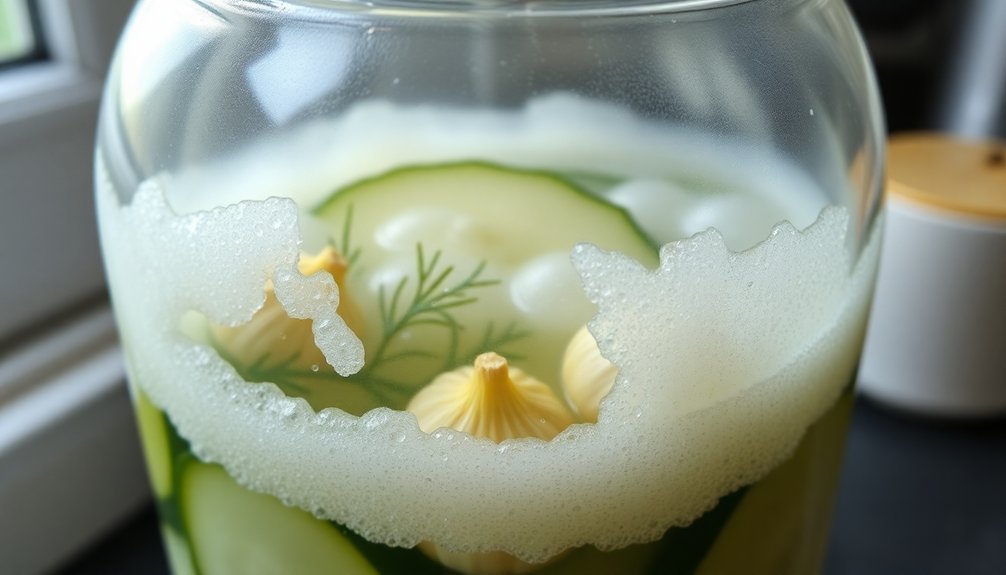
Surface scum frequently appears during pickle fermentation, particularly in the form of kahm yeast – a white, filmy layer that develops when conditions aren't ideal.
You'll need to manage this growth carefully to guarantee your pickles ferment properly and safely. When you spot kahm yeast, you can safely skim it off using a clean utensil.
After removing the surface growth, replace your follower and weight, then cover with plastic wrap to prevent further contamination. While kahm yeast isn't harmful, it often indicates that your fermentation environment needs adjustment – your brine might be too weak, your temperature too warm, or there's too much oxygen exposure.
To prevent unwanted growth, maintain proper salt concentration using pickling or canning salt, and guarantee your cucumbers stay fully submerged in the brine.
Keep your fermentation temperature between 70-75°F, and monitor regularly for signs of spoilage. If you notice blue or green mold, slimy brine, or soft, slippery pickles, you'll need to discard the batch.
While pink mold can sometimes be removed, it's essential to carefully evaluate the ferment's safety before consuming.
Fixing Hollow Pickle Problems
During pickle fermentation, hollow pickles can emerge from several key factors, including over-mature cucumbers, improper brining, and delayed processing times. To prevent this issue, you'll need to carefully select and handle your cucumbers before they enter the fermentation process.
Start by choosing cucumbers less than 2 inches across, as larger ones often develop hollow centers and don't absorb the brine properly.
Time management is vital in pickle fermentation. Don't let your cucumbers sit around after harvesting – process them within 24 hours, or store them in cool conditions if you can't start right away.
When washing your cucumbers, pay attention to any that float, as this usually indicates they're hollow and should be used for relishes instead.
- Select firm, fresh cucumbers without wax coatings for best fermentation
- Begin processing within 24 hours of harvest to maintain cucumber quality
- Maintain proper brine strength and keep cucumbers fully submerged
- Remove floating cucumbers during washing and save them for relish
Proper curing and brining techniques are essential for solid pickles. Verify your brine concentration is correct and that the cucumbers remain well-covered throughout the entire fermentation process to achieve the finest results.
Perfect Brine Temperature Control
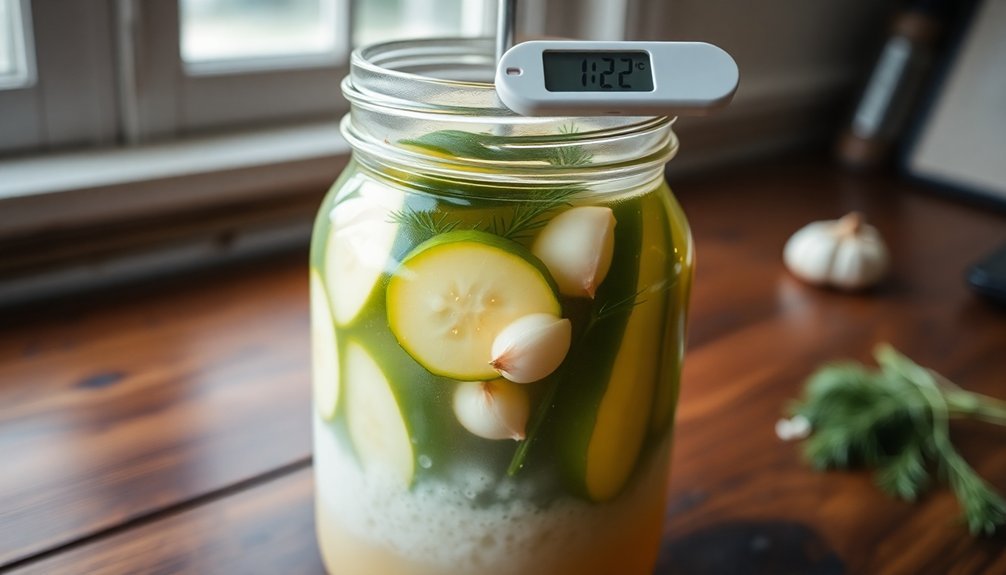
Temperature control plays a central role in successful pickle fermentation, building upon proper cucumber selection and preparation. Your goal is to maintain temperatures between 60°F and 70°F, with 65°F being the sweet spot for ideal fermentation and flavor development.
Watch out for temperature extremes, as they'll greatly impact your pickles' quality. When temperatures rise above 70°F, you'll risk harmful bacteria growth and potentially kill beneficial bacteria above 107°F. Your fermentation might speed up, but you'll sacrifice flavor and texture.
Conversely, temperatures below 58°F will slow fermentation dramatically, potentially leading to contamination and inadequate acid production.
To maintain perfect temperatures, store your fermenting pickles between 70°F and 75°F during the initial curing and brining phase. Keep your containers away from direct sunlight to prevent overheating, and regularly monitor the fermentation area's temperature.
You'll need to adjust your fermentation times based on seasonal changes – longer in cooler months and shorter in warmer periods. Using appropriate containers that maintain stable temperatures will help guarantee consistent results throughout the fermentation process.
Salt Ratios for Success
Proper salt ratios serve as the cornerstone of successful pickle fermentation, with specific concentrations determining your final product's safety, texture, and flavor.
You'll want to maintain ratios between 2% and 5%, as anything lower risks spoilage while higher concentrations can halt fermentation altogether.
For best results, use a 3.5% salt brine (9 grams per cup of water) for refrigerated pickles, or increase to 4.5% (10.8 grams per cup) for longer fermentation periods.
Always use pickling or canning salt, avoiding iodized varieties that can cloud your brine and affect fermentation.
Watch for warning signs that your salt ratio isn't correct. Soft or slippery pickles indicate too little salt, while overly salty taste means you've used too much.
Maintaining proper salt concentration helps prevent mold growth and guarantees beneficial bacteria can thrive.
- Use 3% brine (7g salt per cup) for short 3-5 day ferments
- Choose 3.5% brine (9g salt per cup) for balanced flavor in refrigerated pickles
- Select 4.5% brine (10.8g salt per cup) for traditional full-sour pickles
- Keep fermentation temperature between 70-75°F for best results
Equipment and Tools Matter
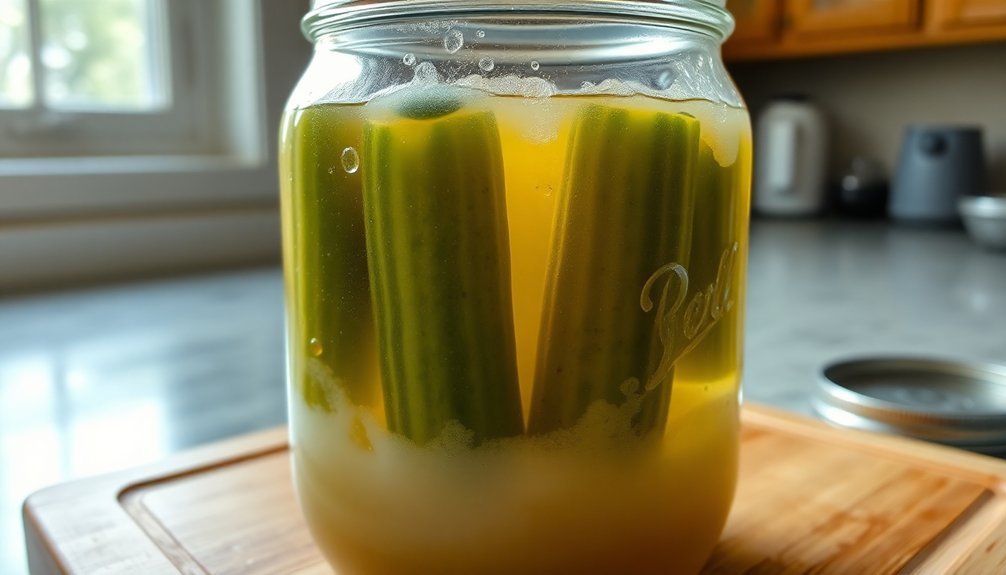
Beyond perfecting your salt ratios, selecting the right equipment can make or break your fermentation success. You'll need proper fermentation vessels, essential tools, and the right materials to guarantee your pickles turn out crisp and flavorful.
Choose glass or ceramic vessels for your ferments, as metal containers can react with acidic brine. Mason jars work well for small batches, while traditional fermentation crocks offer excellent results for larger quantities. Don't forget to invest in proper weights and airlocks to keep your vegetables submerged and prevent oxygen exposure.
| Equipment Type | Recommended | Avoid |
|---|---|---|
| Vessels | Glass jars, ceramic crocks | Metal containers, brass vessels |
| Tools | Stainless steel funnel, mandoline | Copper utensils, zinc tools |
| Salt Types | Pickling salt, canning salt | Iodized salt, flake salt |
| Spices | Whole spices, fresh herbs | Ground spices, powdered seasonings |
For preparation, you'll want a reliable kitchen scale, mandoline for consistent cuts, and fine-mesh colander for washing produce. Use cheesecloth or butter muslin to keep smaller pieces submerged. Remember to regularly "burp" jars without airlocks to prevent pressure buildup, which can lead to exploding containers.
Time-Sensitive Cucumber Processing
The timing of your cucumber processing can make the difference between crisp, flavorful pickles and a mushy disappointment. You'll need to start fermenting your cucumbers within 24 hours of harvest to maintain peak quality. During this significant window, store your cucumbers at 50°F with 90% relative humidity if you can't process them immediately.
Temperature control is vital throughout the entire process. Keep your fermenting cucumbers between 70-75°F for the best results, and once pasteurized, cool them to 70°F or lower before storage. You'll want to maintain consistent temperatures to prevent unwanted texture changes and off-flavors.
- Remove 1/16-inch from the blossom end of each cucumber to eliminate enzymes that cause softening.
- Start with smaller cucumbers for better brine penetration and to avoid hollow pickles.
- Keep cucumbers fully submerged in properly concentrated brine throughout fermentation.
- Process jars in boiling water for the exact recommended time (typically 10-20 minutes) – don't overprocess.
Maintaining these time-sensitive steps carefully will help guarantee your pickles develop the ideal crunch and flavor you're aiming for.
Water Quality Considerations
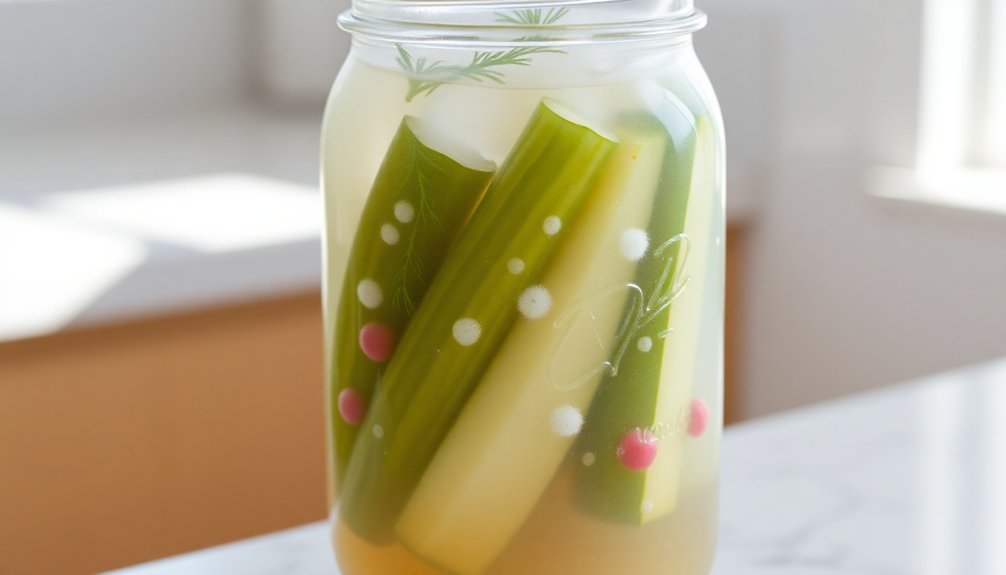
Selecting quality water for your pickle fermentation stands as an essential first step in the process. If you're dealing with hard water, you'll face several challenges that can compromise your pickles' quality. Hard water interferes with proper acid formation and can cause cloudiness, off-colors, and inconsistent fermentation results.
You'll achieve the best results using moderately soft water, which promotes better growth of lactic acid bacteria and maintains brine clarity. If you're stuck with hard water, you can treat it by boiling for 15 minutes and letting it sit for 24 hours. After boiling, remove any scum that forms on top and carefully pour off the water without disturbing the settled sediment at the bottom.
Watch for warning signs of water quality issues in your fermentation. Dark or discolored pickles, excessive cloudiness, and soft or slippery textures often indicate problems with your water source.
While some cloudiness is normal due to beneficial bacteria growth, it shouldn't be accompanied by off-odors or mushiness. Always check your water quality regularly and make adjustments as needed to guarantee successful fermentation.
Spice and Seasoning Selection
While water quality sets the foundation for pickling success, proper spice selection brings your fermented creations to life. You'll want to focus on essential ingredients like mustard seeds, dill, coriander, and peppercorns as your base blend.
For the best results, use whole spices instead of ground versions to prevent discoloration in your pickles, and always guarantee your spices are fresh and stored in airtight containers.
When measuring your spices, stick to about 1½ teaspoons per pint or 1 tablespoon per quart of pickles. You can customize your blend, but don't skip the essential ingredients. If you're concerned about loose spices in your jars, consider using a cheesecloth bag to contain them during the fermentation process.
- Always source fresh, high-quality spices from reputable suppliers to avoid contamination and mold issues
- Store your spice blends in airtight containers to maintain their potency and prevent moisture absorption
- Mix spices evenly throughout your pickling solution for consistent flavor distribution
- Avoid using brass, copper, or zinc utensils when handling spices, as they can cause unwanted discoloration
Frequently Asked Questions
Can I Reuse Leftover Brine From a Previous Batch of Fermented Pickles?
You can reuse leftover pickle brine for new ferments within six months if it's properly refrigerated. Just make sure it's still fresh, add some vinegar for extra flavor, and keep your new vegetables fully submerged.
How Long Can Fermented Pickles Be Safely Stored at Room Temperature?
You shouldn't store fermented pickles at room temperature for extended periods. Once fermentation is complete (3-4 weeks at 70-75°F), move them to the refrigerator where they'll keep for 4-6 months.
Why Do Some Pickle Recipes Require Grape Leaves?
You'll want grape leaves in your pickle recipes because they release tannins that keep your pickles crisp. They naturally inhibit enzymes that would make your pickles soft, especially during fermentation.
Can I Mix Different Varieties of Cucumbers in the Same Fermentation Batch?
You can mix different cucumber varieties, but you'll get better results using similar-sized ones. Stick to English, pickling, or Persian cucumbers together, and avoid mixing in slicing cucumbers for consistent fermentation.
What's the Best Way to Weigh Down Floating Cucumbers During Fermentation?
Use glass fermentation weights or fill a ziplock bag with brine to keep your cucumbers submerged. You'll want to guarantee they're tightly packed and completely covered by the brine to prevent spoilage.
In Summary
Your pickle fermentation success depends on attention to detail and quick action when issues arise. You'll prevent most common problems by selecting fresh cucumbers, maintaining proper brine strength, and controlling fermentation temperatures. Don't let surface scum, hollow centers, or discoloration discourage you – these issues have simple fixes. With the right equipment and careful monitoring, you'll master the art of crisp, flavorful fermented pickles.

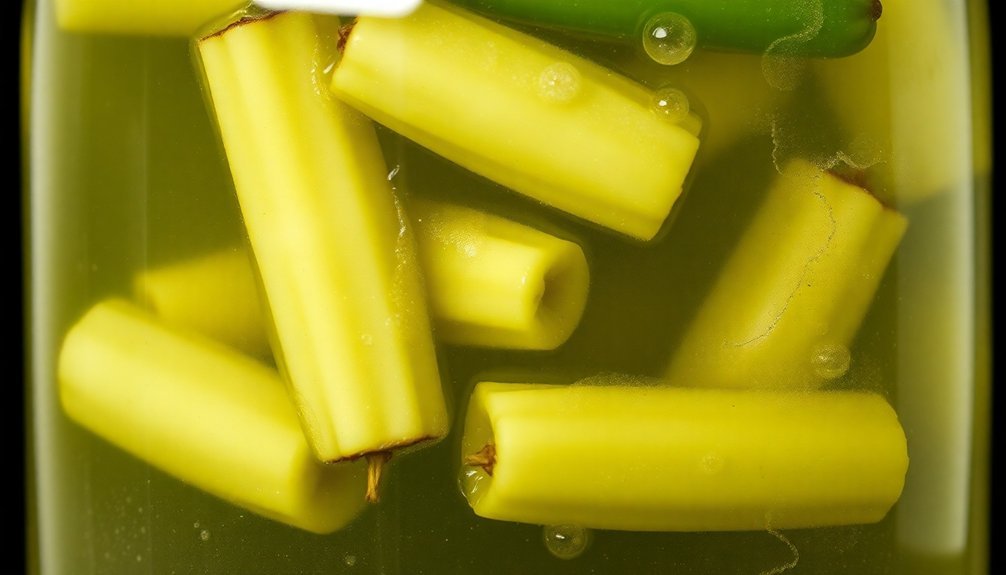



Leave a Reply